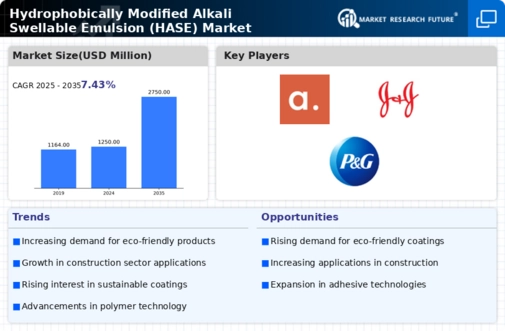Top Industry Leaders in the Hydrophobically Modified Alkali Swellable Emulsion Market

The Hydrophobically Modified Alkali Swellable Emulsion (HASE) market is experiencing a surge, driven by its unique properties and versatile applications in industries like paints & coatings, adhesives, and personal care. Understanding the competitive landscape is crucial for both established players and new entrants to navigate this dynamic market. This report delves into the key strategies, market share factors, industry news, recent developments, and a summary of the HASE market.
Strategies Adopted by Key Players:
-
Product Differentiation: Leading companies like Dow Chemical and BASF are investing in research and development to create HASE polymers with tailored properties for specific applications. This includes developing emulsions with higher thickening efficiency, improved shear stability, and enhanced compatibility with different formulations. -
Geographic Expansion: Established players are expanding their reach into emerging markets like Asia Pacific and Latin America, where the demand for HASE is expected to grow significantly. This involves setting up production facilities, establishing distribution channels, and forging partnerships with local companies. -
Sustainability Focus: As environmental concerns gain traction, companies are emphasizing the eco-friendly benefits of HASE polymers. This includes using bio-based raw materials, developing low-VOC formulations, and highlighting the reduced water consumption enabled by HASE in various applications. -
Vertical Integration: Some companies are vertically integrating their operations to gain greater control over the entire HASE production chain. This allows them to optimize costs, ensure quality, and respond quickly to market demands. -
Acquisitions and Collaborations: Mergers and acquisitions are becoming increasingly common in the HASE market, as companies seek to consolidate their positions and acquire new technologies. Additionally, collaborations between manufacturers and research institutions are fostering innovation and accelerating the development of novel HASE applications.
Factors Influencing Market Share:
-
Product Quality and Performance: The ability to deliver HASE polymers with consistent quality, superior performance, and tailored properties for specific applications plays a significant role in determining market share. -
Brand Reputation and Customer Relationships: Established brands with strong reputations and existing customer relationships have an advantage in attracting new clients. Building trust and demonstrating a commitment to customer satisfaction is crucial for long-term success. -
Pricing Strategy and Cost Competitiveness: Finding the right balance between price and profitability is essential. Companies need to offer competitive pricing while maintaining healthy margins to invest in research and development. -
Distribution Network and Customer Service: Having a robust distribution network and providing excellent customer service are crucial for ensuring timely delivery, technical support, and prompt resolution of customer issues. -
Regulatory Compliance: Navigating the complex regulatory landscape of different countries is essential for ensuring market access and avoiding legal complications.
Key Players
Some of the prominent players operating in the Global Hydrophobically Modified Alkali Swellable Emulsion are Arkema Group (France), BASF SE (Germany), The Lubrizol Corporation (U.S.), The Dow Chemical Company (U.S.), THE EUCLID CHEMICAL COMPANY (U.S.), 3V Sigma s.p.A. (Italy), AkzoNobel N.V (the Netherlands), Scott Bader Company Ltd. (U.K), CADY (U.S.) and others.
Recent Developments:
November 2023: Focus on new product launches with enhanced functionalities for specific applications, particularly in the personal care and construction chemicals sectors.
December 2023: Increased emphasis on sustainability initiatives, including the use of bio-based raw materials and the development of low-VOC HASE formulations.
January 2024: Expected rise in mergers and acquisitions as companies seek to consolidate their positions and expand their product portfolios.









